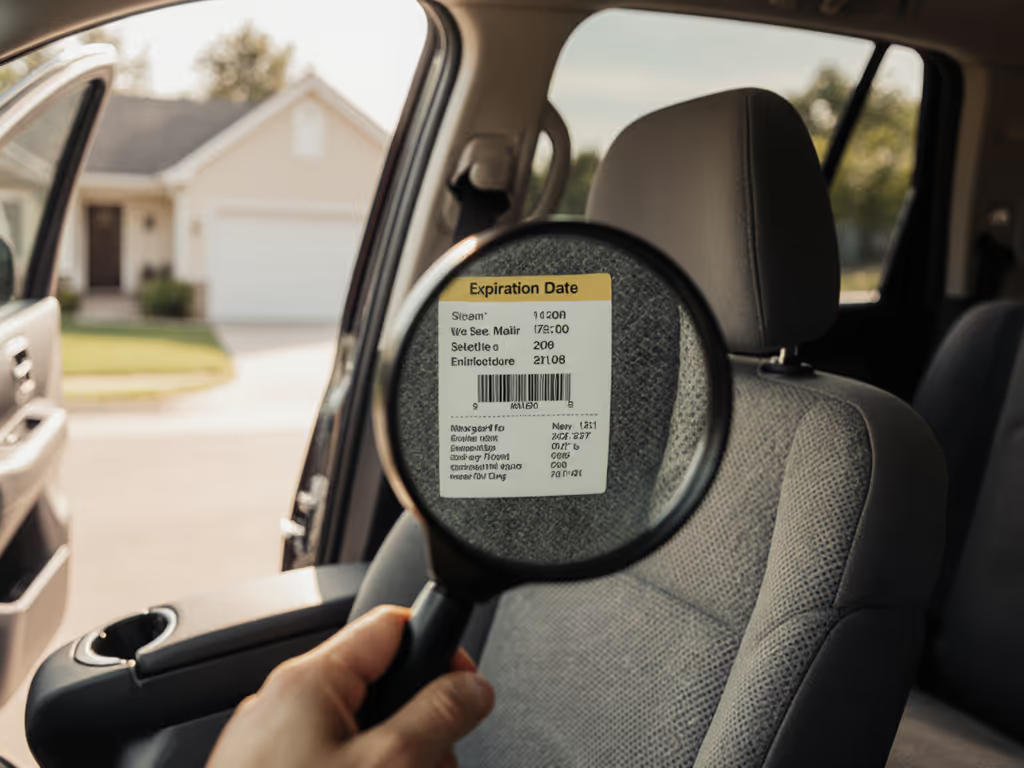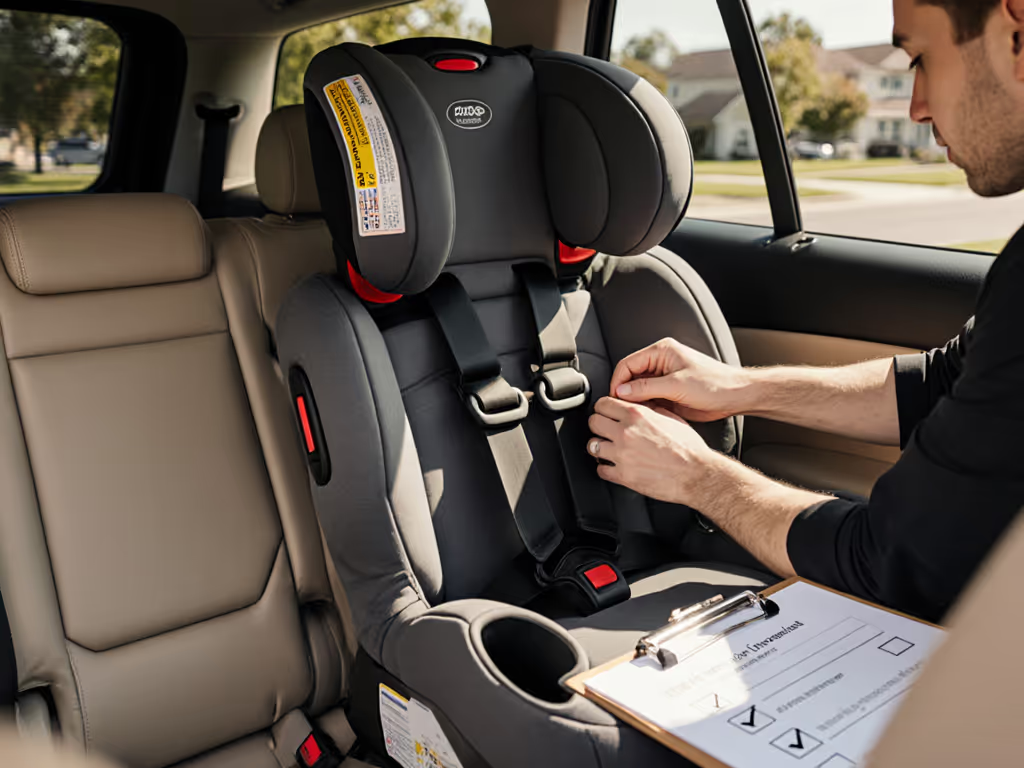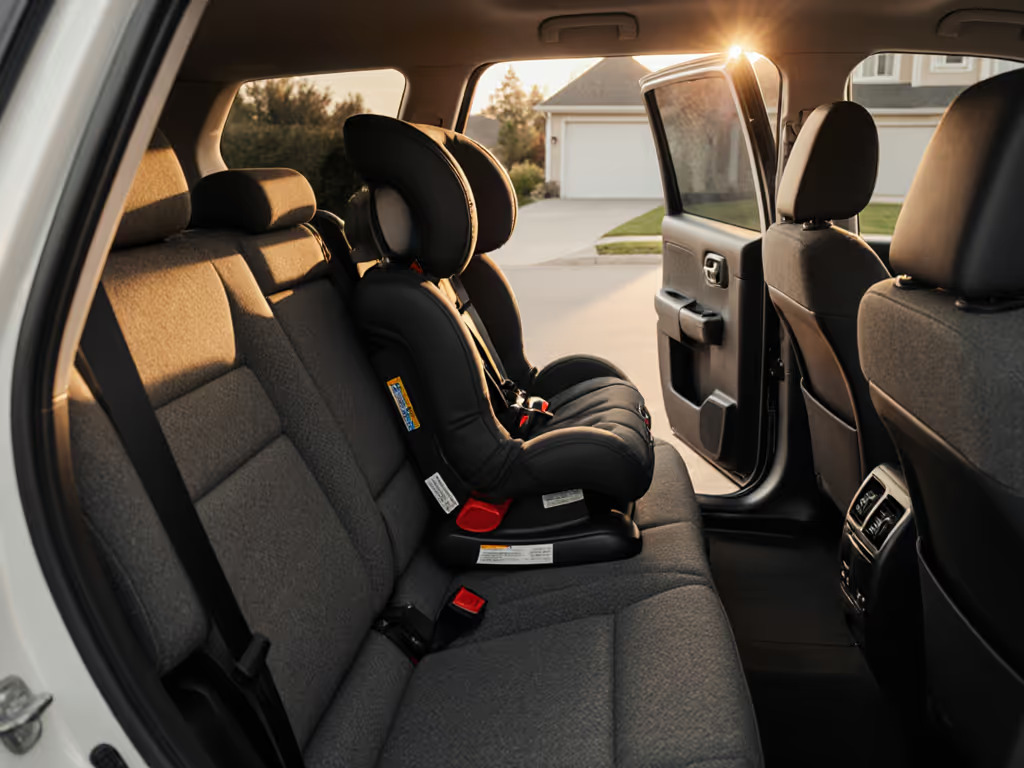
Car Seat Safety Ratings Explained: Comprehensive Guide

Most parents focus on finding the safest car seat, yet even the highest-rated option offers little protection if misunderstood. With so many brands and models on the market, making sense of car seat safety ratings becomes a key first step. Child car seats can reduce fatal injury risk by up to 71 percent for infants. Here you’ll discover how these ratings work, why they matter, and what truly helps keep your child secure every time you travel.
Key Takeaways
| Point | Details |
|---|---|
| Understanding Ratings | Car seat safety ratings assess crash protection, installation ease, instruction clarity, and securing mechanisms to aid informed choices for parents. |
| Stay Informed | Safety ratings evolve as manufacturers innovate; regularly check updates and consult safety technicians for accurate guidance. |
| Engagement is Key | Proper use of car seats greatly impacts safety; parents must understand installation and maintenance to maximize protection. |
| Avoid Common Mistakes | Misinterpretations of safety ratings can lead to false security; always consider specific fit, installation instructions, and regular inspections. |
What Are Car Seat Safety Ratings?
When it comes to protecting your child during travel, car seat safety ratings are more than just numbers. These ratings represent a comprehensive evaluation system designed to help parents understand the potential protection levels of child restraint systems. The National Highway Traffic Safety Administration (NHTSA) developed a standardized rating mechanism to provide clear, actionable insights into how different car seats perform under various crash scenarios.
The primary goal of car seat safety ratings is to give parents an objective measurement of a car seat's performance and ease of use. These ratings typically cover multiple critical dimensions:
- Crash Protection Performance: How well the seat protects a child during different types of collisions
- Installation Ease: How straightforward it is to correctly secure the seat in a vehicle
- Instruction Clarity: How well the manufacturer explains proper seat usage
- Securing Child Features: The effectiveness of harness systems and child restraint mechanisms
NHTSA uses a 5-Star Safety Rating system, with 5 stars representing the highest level of safety and 1 star indicating the lowest. This rating helps parents make informed decisions by providing a standardized comparison across different car seat models. The ratings are not just about raw safety statistics but also consider practical elements like how intuitive the seat is to install, how clear the instructions are, and how effectively a child can be secured.
Understanding these ratings isn't just about selecting a seat with the most stars. Parents should also consider their specific vehicle type, child's age and size, and individual installation requirements. A 5-star rated seat that doesn't fit properly in your specific vehicle won't provide the protection you need. Always consult with a certified child passenger safety technician who can provide personalized guidance based on your unique circumstances.
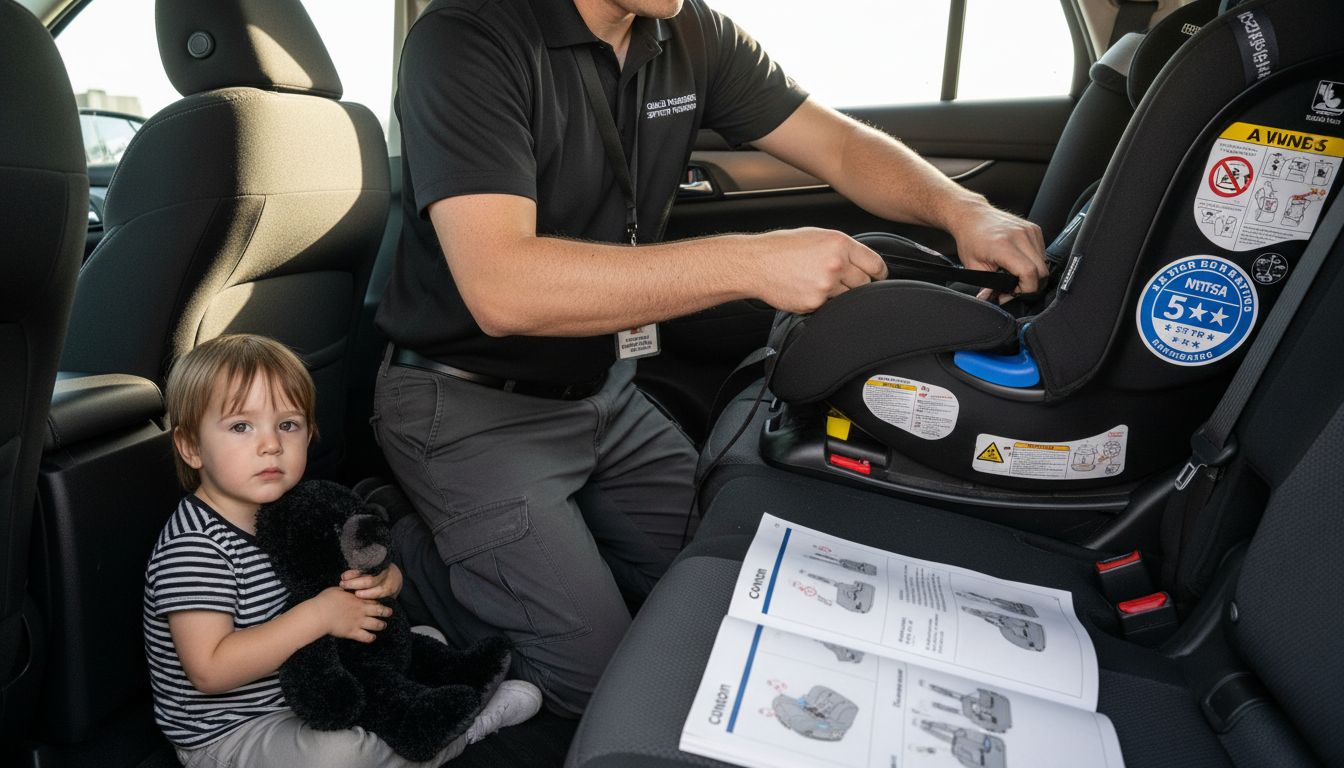
Types and Sources of Safety Ratings
Car seat safety ratings originate from multiple authoritative sources, each offering unique perspectives and evaluation criteria. The National Highway Traffic Safety Administration (NHTSA) stands as the primary reference point for car seat safety assessments in the United States, providing comprehensive ratings that parents can trust. Their rating systems go beyond simple numerical scores, diving deep into critical aspects of child passenger protection.
Three primary types of safety ratings dominate the car seat evaluation landscape:
- NHTSA Ease of Use Ratings: A 5-star system evaluating car seat installation complexity, instruction clarity, and securing mechanisms
- Crash Protection Ratings: Assessing a car seat's performance during simulated crash scenarios
- Specific Feature Ratings: Analyzing individual design elements like harness quality, material durability, and ergonomic considerations
While NHTSA leads domestic evaluations, international organizations like the European New Car Assessment Programme (Euro NCAP) provide additional perspectives on vehicle and child restraint system safety. These global rating systems help manufacturers develop increasingly sophisticated safety technologies by establishing rigorous performance benchmarks.
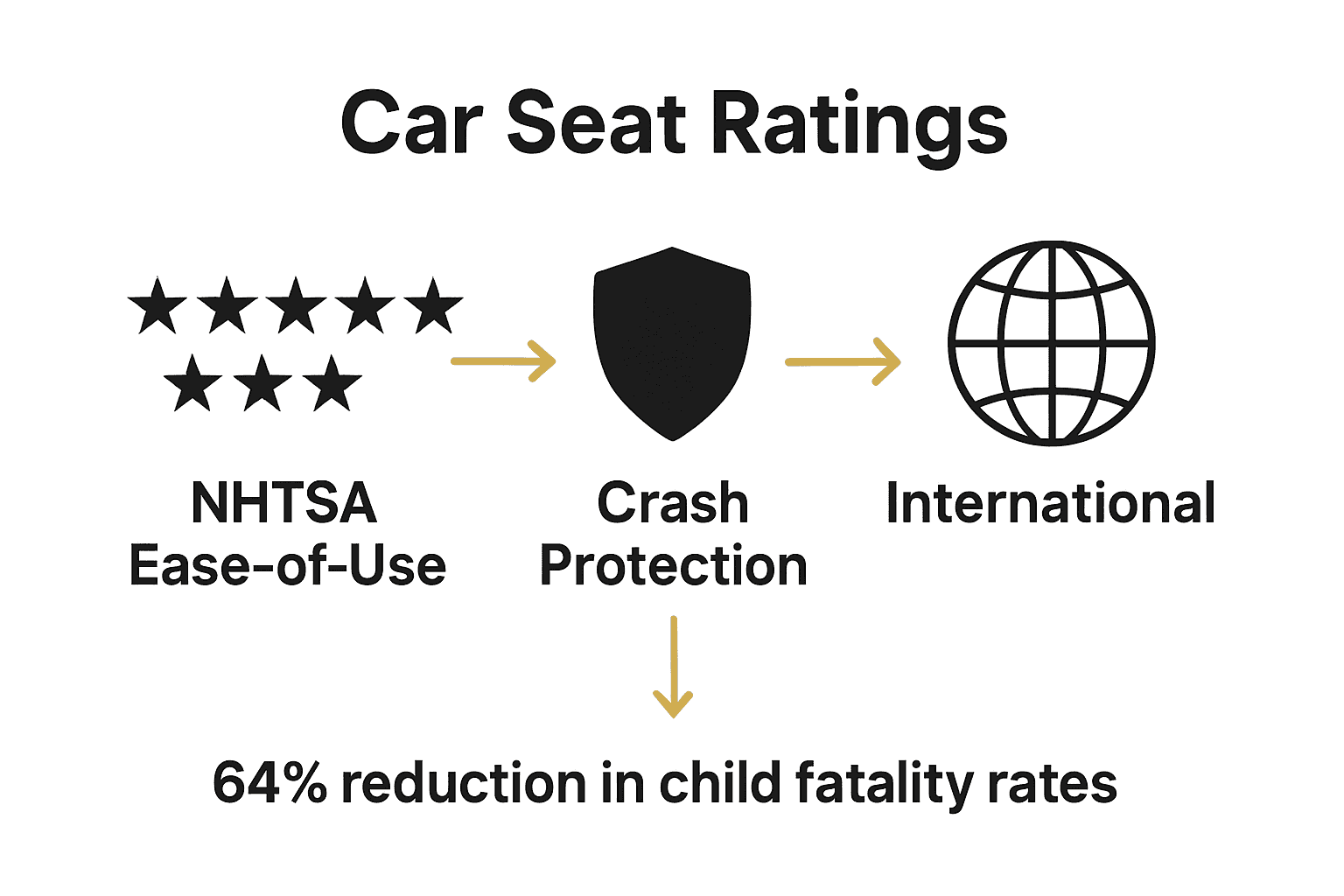 Though their specific methodologies might vary, they share a common goal: protecting child passengers through data-driven design and comprehensive testing.
Though their specific methodologies might vary, they share a common goal: protecting child passengers through data-driven design and comprehensive testing.
Parents should recognize that safety ratings are dynamic, evolving tools. Manufacturers continuously improve design standards, and rating criteria get updated to reflect the latest research in child passenger protection. A car seat's rating today might change tomorrow as new safety technologies emerge. Smart parents stay informed by regularly checking the latest NHTSA ratings, consulting child passenger safety technicians, and understanding that ratings are guidance tools, not absolute guarantees of protection.
How Safety Ratings Are Determined
Safety ratings are not arbitrary numbers but the result of rigorous scientific testing and comprehensive evaluation processes. The National Highway Traffic Safety Administration (NHTSA) employs a systematic approach that goes far beyond simple visual inspections. These ratings involve sophisticated crash simulations, detailed performance assessments, and extensive data collection designed to replicate real-world scenarios where child safety is paramount.
The rating determination process typically involves several critical stages:
- Crash Test Simulations: Controlled laboratory environments where car seats are subjected to multiple impact scenarios
- Installation Analysis: Detailed assessment of how easily and correctly a car seat can be installed in different vehicle types
- Material Durability Testing: Evaluating seat materials under stress, temperature variations, and repeated use
- Biomechanical Modeling: Using advanced computer simulations to predict child protection during potential collision events
Advanced technologies play a significant role in modern safety rating methodologies. Machine learning algorithms now help researchers predict potential safety outcomes by analyzing thousands of historical crash data points. These computational models can identify subtle design characteristics that might enhance or compromise child protection. Researchers examine everything from harness strap geometry to energy absorption capabilities, creating a comprehensive picture of a car seat's protective potential.
Parents should understand that safety ratings represent a snapshot of performance at a specific time. Manufacturers continuously innovate, and rating criteria evolve. What earns a top rating today might be considered standard tomorrow. The goal isn't just to assign stars but to drive continuous improvement in child passenger protection technologies. Always view these ratings as guidance tools that complement professional advice, thorough research, and your specific family's unique transportation needs.
Real-World Impact on Child Protection
The real-world effectiveness of car seat safety ratings isn't just about numbers on a page - it's about saving young lives. Research consistently demonstrates that properly selected and installed car seats can reduce child fatality risks by up to 71% for infants and 54% for toddlers during vehicle collisions. These aren't just statistics; they represent countless children who have been protected by advanced safety engineering and careful parental selection.
Key factors that translate safety ratings into tangible protection include:
- Precise Age and Size Matching: Selecting seats specifically designed for a child's current developmental stage
- Correct Installation Technique: Ensuring the seat is securely anchored using either LATCH systems or seat belts
- Consistent Harness Usage: Maintaining proper harness tightness and positioning for maximum restraint
- Regular Seat Inspection: Checking for wear, damage, and potential recall notifications
The Insurance Institute for Highway Safety (IIHS) emphasizes that car seat effectiveness goes beyond initial manufacturing. Ongoing maintenance, understanding specific usage guidelines, and staying updated on the latest safety recommendations are crucial. Manufacturers continually refine designs based on real-world crash data, transforming each generation of car seats into more sophisticated protection systems. This means today's car seats are significantly more advanced than those from just a decade ago.
Parents must understand that a high safety rating is just the beginning. Active engagement - staying informed about proper usage, attending local car seat safety workshops, and consulting certified child passenger safety technicians - transforms those ratings into genuine protection. Your commitment to understanding and implementing best practices is the final, most critical layer of child safety during transportation.
Mistakes to Avoid When Using Ratings
Safety ratings can be powerful tools, but misinterpreting them can lead parents into a false sense of security. Many well-intentioned caregivers make critical errors when selecting and using car seats based solely on star ratings. Understanding these potential pitfalls is crucial to ensuring genuine child protection beyond the numerical score printed on packaging.
Common mistakes parents frequently encounter include:
- Overlooking Specific Fit Requirements: Assuming a high-rated seat automatically works for every vehicle or child
- Ignoring Installation Instructions: Treating manufacturer guidelines as suggestions rather than mandatory procedures
- Rating Comparison Across Different Systems: Mistakenly comparing ratings from NHTSA with international rating systems without understanding their unique methodologies
- Neglecting Regular Seat Inspections: Believing a high rating means permanent, unchanging safety without ongoing maintenance
The National Highway Traffic Safety Administration strongly cautions against treating safety ratings as absolute guarantees. Ratings represent controlled testing scenarios that cannot perfectly predict every real-world collision circumstance. A 5-star rated seat must still be correctly matched to your specific vehicle, installed with precision, and regularly checked for potential wear or damage. Professional child passenger safety technicians recommend viewing ratings as guidance tools that complement - not replace - careful, informed decision-making.
Ultimately, the most advanced safety rating cannot compensate for improper use. Parents must invest time in understanding their specific car seat's unique requirements, attending safety workshops, and staying current with the latest child passenger protection research. Your active engagement and commitment to proper usage transform those star ratings from abstract measurements into genuine, life-saving protection for your child.
Make Every Star Count with the Right Car Seat for Your Child
Choosing a car seat with a high safety rating is just the first step in protecting your little one on the road. The article highlights real challenges parents face like finding a seat that fits their child's size, matches their vehicle type, and can be installed correctly every time. These crucial factors often cause worry and confusion because even a 5-star rated seat can fail to deliver safety if it is not the right fit or installed properly. Understanding crash protection, installation ease, and correct harness use is essential for turning ratings into real-world safety.
At Fits for Years Seats, we specialize in guiding families through these exact challenges. Our in-depth reviews and comprehensive buying guides focus on convertible car seats that offer safety, comfort, and long-term usability tailored to your child’s age and size. Don't let uncertainty put your child's safety at risk. Explore our expert advice on selecting and maintaining the perfect seat to ensure you make the most of those vital safety stars. Visit Fits for Years Seats now and start confidently protecting your child today.
Frequently Asked Questions
What do car seat safety ratings represent?
Car seat safety ratings provide an objective measurement of a car seat's performance, ease of use, and effectiveness in protecting children during vehicle collisions. They consider crash protection, installation ease, instruction clarity, and child securing features.
How are car seat safety ratings determined?
Car seat safety ratings are determined through rigorous testing, including crash simulations, installation analysis, material durability testing, and biomechanical modeling. The NHTSA uses a 5-star system to convey safety effectiveness.
What should I consider when choosing a car seat based on safety ratings?
When choosing a car seat, consider your specific vehicle type, your child's age and size, and the seat's installation requirements. A highly rated seat must also fit correctly in your vehicle to provide optimal protection.
How can I ensure my car seat remains safe over time?
To ensure your car seat remains safe, regularly inspect it for wear and damage, follow the manufacturer's installation guidelines, and stay updated on safety recommendations. Proper use and maintenance are crucial for long-term protection.


